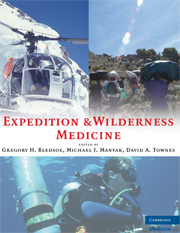Book contents
- Frontmatter
- Contents
- Contributors
- Foreword
- Preface
- Acknowledgments
- PART I EXPEDITION PLANNING
- PART II EXPEDITIONS IN UNIQUE ENVIRONMENTS
- 13 Tactical and Protective Medicine
- 14 Hostile Geopolitical Environments
- 15 Aerospace Medicine
- 16 Polar Medicine
- 17 Tropical Medicine for Expeditions
- 18 Subterranean Medicine
- 19 High-Altitude Medicine
- 20 Medicine at Sea
- 21 Event Medicine
- 22 Telemedicine in Evolution: Implications for Expeditionary Medicine
- 23 Dive Medicine
- PART III ILLNESS AND INJURIES ON EXPEDITIONS
- APPENDIX The Expedition Medical Kit
- Index
23 - Dive Medicine
from PART II - EXPEDITIONS IN UNIQUE ENVIRONMENTS
Published online by Cambridge University Press: 05 March 2013
- Frontmatter
- Contents
- Contributors
- Foreword
- Preface
- Acknowledgments
- PART I EXPEDITION PLANNING
- PART II EXPEDITIONS IN UNIQUE ENVIRONMENTS
- 13 Tactical and Protective Medicine
- 14 Hostile Geopolitical Environments
- 15 Aerospace Medicine
- 16 Polar Medicine
- 17 Tropical Medicine for Expeditions
- 18 Subterranean Medicine
- 19 High-Altitude Medicine
- 20 Medicine at Sea
- 21 Event Medicine
- 22 Telemedicine in Evolution: Implications for Expeditionary Medicine
- 23 Dive Medicine
- PART III ILLNESS AND INJURIES ON EXPEDITIONS
- APPENDIX The Expedition Medical Kit
- Index
Summary
INTRODUCTION
The underwater world holds the largest unexplored expanses on our planet and naturally invites those with the curiosity and determination to undertake the challenge. Shipwrecks, cave exploration, scientific surveys have always provided the impetus for exploration and discovery and continue to provide new opportunities. New technology and resources serve to open up to divers previously inaccessible areas that were not possible only a few years ago. Privately organized expeditions on the scale of public and academic efforts have become increasingly common and will continue to become more prevalent (Figure 23.1).
This expansion in undersea exploration continues to push into some of the most remote areas that are far from any support bases. Individuals and expeditions undertaking such ambitious plans face unique challenges that must be addressed to ensure the success of their mission. Planning and preparation are essential in this success and must be approached with this in mind. In remote locations, there is little tolerance for poor planning compared to those areas with greater accessibility and resources.
The undersea environment imposes unique physical environmental changes on the physiology of the human body, which need to be recognized in order to prevent injury. The increased ambient pressure at depth causes changes in gas behavior in our tissues and organs. Encounters with marine creatures may result in injury or envenomation. The management and avoidance of potential adverse consequences of these may be different in remote locations and need to be anticipated.
- Type
- Chapter
- Information
- Expedition and Wilderness Medicine , pp. 323 - 342Publisher: Cambridge University PressPrint publication year: 2008



